Differences Between One and Two Carat Princess Cut Diamonds
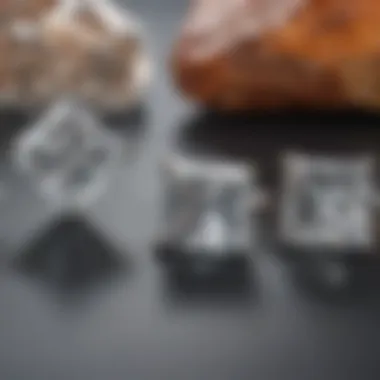
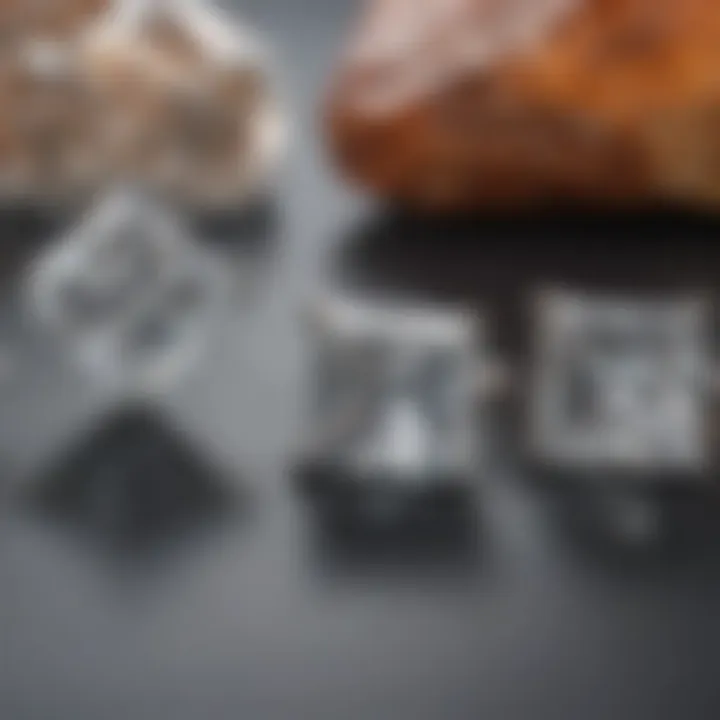
Intro
When it comes to purchasing a diamond, particularly a princess cut one, many potential buyers find themselves caught in a quagmire of choices. The allure of a striking diamond shines brightly, yet questions linger—how important is the carat weight? What makes a one carat diamond different from its two carat counterpart? This article seeks to dissect these questions, helping gemstone enthusiasts navigate through the intricacies involved in diamond selection. By understanding the comparative aspects of one carat and two carat princess cut diamonds, one becomes better equipped to make informed purchase decisions.
Gemstone Overview
Definition and Characteristics
Princess cut diamonds are one of the most popular fancy shapes available today. They are known for their modern, geometric design that balances an elegant appearance with maximum brilliance. Ideally, a princess cut diamond features four well-defined corners, which set it apart from other cuts like the round brilliant. In terms of weight, a one carat diamond typically measures 6.5mm in diameter, while a two carat diamond expands to about 8.1mm. The size difference is apparent, but it's essential to delve deeper into how these dimensions affect appearance and value.
Classification of Gemstones
When discussing diamonds, they fall under the broader classification of gemstones, which can be categorized based on various factors including hardness, refractive index, and origin. Diamonds rank a perfect ten on the Mohs scale of mineral hardness, making them one of the hardest substances on earth. They are classified into two main categories: natural and synthetic. Natural diamonds form over millions of years beneath the Earth’s crust, while synthetic diamonds, created in labs, reflect the same physical qualities but under different circumstances.
Historical Significance
Ancient Uses and Cultural Importance
Throughout history, diamonds have been steeped in rich traditions. Ancient civilizations believed diamonds embodied the strength of their gods. They were often used in royal crowns or as tokens of love in companionship. The enduring association of diamonds with engagement rings solidified their cultural importance, with many societies believing that the stone could protect against negative forces and ensure fidelity.
Myths and Legends Surrounding Gemstones
Diamonds have not only dazzled with their brilliance but also captured the imagination through various myths. One popular tale suggests that diamonds were once believed to be divinely inspired fragments of stars, thus symbolizing clarity and purity. The belief in their mystical qualities extends further, as some cultures consider possessing a diamond to bring good fortune and ward off evil spirits.
Prelims
When it comes to selecting the perfect diamond, carat weight is a pivotal factor that can dramatically influence both the stone's appearance and its market value. This article aims to dissect the nuances between one carat and two carat princess cut diamonds, providing a detailed comparative analysis that goes beyond sheer numbers. Understanding these distinctions is essential for anyone—be it a buyer, collector, or jeweler—who wishes to make wise purchasing decisions.
The significance of carat weight goes hand in hand with visual impact and emotional resonance. A diamond’s carat weight not only impacts its physical dimensions but also its brilliance and perceived size, leading many to consider how much bling they want on their finger or in their collection. The reality is, there’s more here than meets the eye. Weight doesn’t just reflect value; it also alters how a diamond interacts with light, the sparkle it produces, and ultimately the statement it makes.
Understanding the Importance of Carat Weight
Carat weight is often seen as the benchmark for a diamond’s worth. However, it can also be a mixed blessing. For instance:
- A one carat princess cut diamond will appear significantly different in size and presence when compared to its two carat counterpart.
- In settings, the perceived size can be altered based on various factors, including the design of the ring and the metal used.
- Emotional considerations, like the symbolism associated with different carat weights, play a vital role in how individuals choose their diamonds, especially for engagements.
Importantly, while larger diamonds tend to garner more attention and can create a more imposing presence, one carat diamonds can be just as stunning in the right setting. Thus, every piece of jewelry tells its own story, shaped by the size, cut, and the personal choices of its wearer.
"In the world of diamonds, bigger isn’t always better; sometimes it’s the precise blend of size, cut, and personal significance that makes a gem truly shine."
The journey into understanding one carat versus two carat diamonds extends well beyond mere measurements, prompting considerations of quality, craftsmanship, and individual taste. As we delve further, we will explore these dimensions in greater detail to arm prospective buyers with the information they need to make an informed choice.
Defining the Princess Cut
Defining the princess cut is crucial in understanding the intricacies of diamonds. This cut, known for its modern elegance and brilliance, offers both aesthetic and technical benefits that captivate gemstone enthusiasts. When discussing princess cut diamonds, one can’t overlook their unique appeal— blending a square shape with the traditional brilliance of diamond facets. This section aims to illuminate the reasons why the princess cut has become a preferred choice for many and how it stands apart from other diamond shapes.
Characteristics of Princess Cut Diamonds
Princess cut diamonds exhibit a distinctive combination of size and sparkle. This cut typically features sharp corners and a brilliant faceting pattern, allowing for remarkable light dispersion. Unlike the round brilliant cut, which is the most popular, the princess cut converts more rough stone into diamond weight. This efficiency makes the stone appear larger than it’s actual weight, a good selling point for buyers.
Here are some core characteristics:
- Shape and Facet Arrangement: Usually square or rectangular, princess cuts have anywhere from 58 to 76 facets, creating a dazzling effect.
- Light Performance: The cut maximizes internal light reflection, causing the diamond to sparkle intensely. This brilliance ranks it second only to the round cut.
- Visual Versatility: Works well in various settings, from modern to vintage styles, adapting seamlessly to different tastes.
The appeal of princess cut diamonds boils down to their modern yet timeless aesthetic, setting them apart in the world of gemstones.
Historical Background of the Princess Cut
The historical timeline of the princess cut diamond is intriguing, to say the least. Developed in the late 1970s by Betzalel Ambar and Israel Itzkowitz, this cut was designed to enhance the beauty of rough diamonds while preserving as much carat weight as possible. Initially termed the "profile cut," it wasn’t until the 1980s that it adopted the name "princess cut" and gained traction in the luxury jewelry market.
Key points in its evolution include:
- 1970s: Introduction aimed at enhancing diamond value and spark.
- 1980s: Gaining popularity through celebrity endorsements and fashion, becoming a common choice for engagement rings.
- Present Day: The princess cut holds a significant portion of the diamond market alongside traditional cuts, often viewed as a progressive alternative.
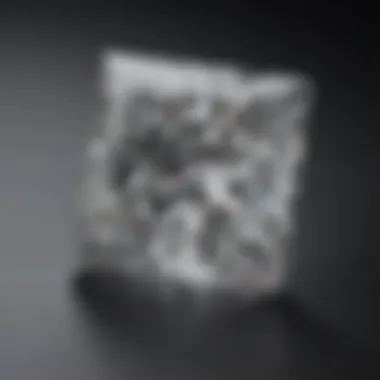
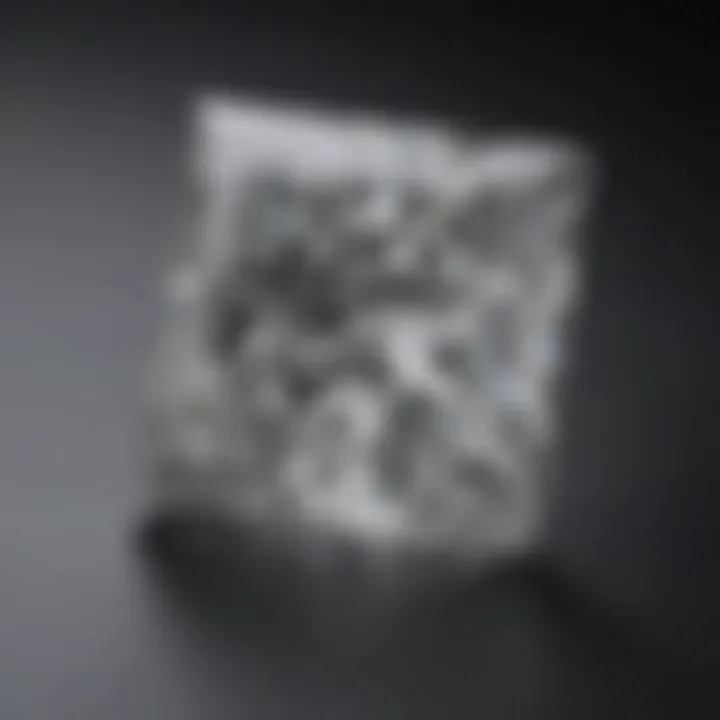
The significant journey of the princess cut reflects the evolving nature of gemology and consumer preferences, showcasing a blend of technological advancement and aesthetic desire.
"When investing in a princess cut diamond, understanding its characteristics and history enriches the purchase experience, turning a mere transaction into an informed investment."
In summation, appreciating the princess cut involves grasping its defining features and historical significance, which together pave the way for an informed decision by consumers and collectors alike.
One Carat Princess Cut: An Overview
When it comes to diamonds, the one carat princess cut stands as a prominent choice for many buyers due to its unique blend of beauty and accessibility. This section delves into the dimensions, quality factors, and overall significance of the one carat princess cut in the grand tapestry of diamond selection. It's not just a piece of jewelry; it's a symbol of taste and commitment for those looking to make a statement without breaking the bank.
Dimensions and Size Perception
Depth and Table Ratio
The depth and table ratio plays a pivotal role in how a one carat diamond appears to the naked eye. A balanced depth and table ratio can greatly enhance a diamond's brilliance and scintillation. In princess cut diamonds, an ideal table percentage usually ranges between 65-75%, while the depth should fall between 60-70%. This balance creates a visual harmony, allowing the diamond to reflect light beautifully.
Choosing a diamond with these specifications not only maximizes its radiance but also ensures that it appears larger than its actual size, giving buyers excellent value. However, if these proportions are off, you might end up with a stone that looks dull or, worse yet, too deep which can cause a loss of light performance.
"A proper depth and table ratio can transform a humble one carat diamond into a dazzling centerpiece, making it a sought-after choice among buyers."
Visual Impact in Various Settings
The visual impact of a one carat princess cut is notably versatile. In various settings, whether it's a simple solitaire ring or an intricate halo design, the diamond's aesthetics can shift dramatically. For instance, in a solitaire setting, the diamond stands alone, showcasing its brilliance and fire prominently. On the other hand, in a halo style, it can appear even more substantial, as smaller stones frame the center diamond.
This adaptability in appearance ensures that a one carat princess cut can fit seamlessly into multiple styles and occasions, appealing to a broad array of tastes. However, buyers should be mindful of how different settings can either enhance or overshadow the diamond's natural beauty.
Quality Factors
Color and Clarity Grades
Color and clarity grades are imperative in assessing the quality of a one carat princess cut diamond. The GIA and other grading entities follow a scale for clarity from Flawless (FL) to Included (I), while the color scale runs from D (colorless) to Z (light yellow). Aiming for a diamond in the G-H range provides a beautiful balance, offering near-colorless appearance without the inflated price of completely colorless options.
In terms of clarity, choosing a stone with at least a VS2 grade ensures that any inclusions are minor and barely perceptible to the untrained eye. This combination of factors is not just about aesthetics; it is essential for making a wise investment. A clarity and color assessment coupled with ideal cut properties guarantees that you possess a diamond that exhibits delightful sparkle and durability over time.
Cut Quality Assessment
Cut quality is often deemed the cornerstone of a diamond's overall appearance and performance. For the princess cut, precise angles and proportions are crucial. Each facet plays a role in how light interacts with the diamond, which means a well-cut stone can achieve a mesmerizing shimmer. Evaluating cut quality goes beyond just measurements; it's an art that factors in light refraction performance.
A well-executed princess cut can deliver an exceptional balance of brilliance and fire, captivating the eye. However, an inferior cut can result in a loss of light, rendering the diamond lackluster despite good color and clarity. Hence, when considering a one carat stone, one should always prioritize the cut quality, ensuring that it meets or exceeds the standard criteria established by reputable grading labs.
Two Carat Princess Cut: An Examination
When delving into the world of premium gemstones, the two carat princess cut diamond stands as a formidable option for many buyers. Not only does it offer a significant visual presence, but it also embodies various elements of craftsmanship that elevate its appeal. Here, we scrutinize the dimensions and size perception, along with the essential quality factors that contribute to the overall evaluation of two carat diamonds.
Dimensions and Size Perception
Depth and Table Ratio
The depth and table ratio are crucial metrics that provide insight into how light interacts within the diamond. For a two carat princess cut, the ideal depth typically hovers around 60% to 70%. A well-proportioned depth leads to enhanced brilliance and sparkle, giving it a lush appearance. A too-deep diamond may obscure light, resulting in a less favorable look, whereas a shallow diamond might lead to windowing, where light escapes instead of reflecting.
The key characteristic here hinges on balance. A diamond that melds the right depth with an optimal table ratio enables light to maximize reflective qualities, showcasing the stone's brilliance. For those on the journey of purchasing, understanding these nuanced elements can make a tangible difference in the diamond's perceived quality.
_"The depth and table ratio can significantly alter how a diamond's fire and brilliance are perceived, akin to the way stage lighting can enhance a performance."
Additionally, the unique feature of crafting in this ratio allows owners to experience the beauty of the diamond while also attracting attention. One advantage to note is that a well-proportioned stone may provide more durability compared to others, as structural integrity is maintained. However, buyers should also be mindful that standards vary amongst jewelers, making it essential to rely on reputable sources for grading.
Appearance in Settings
When viewed in various settings, a two carat princess cut diamond conveys a palpable elegance, morphing seamlessly from classic to contemporary styles. Its sharp lines pair beautifully with different metals, such as platinum, yellow gold, or rose gold. The diamond's geometry presents a striking silhouette, making it the centerpiece in engagement rings or other fine jewelry.
The key characteristic of this appearance is versatility. Whether set in a statement ring or styled with accent stones, the two carat diamond exhibits a captivating shine that draws the eye. The unique feature that stands out here is how the setting can amplify the diamond's perceived size. A well-chosen halo, for instance, can enhance its brilliance further.
On the downside, larger stones may command more consideration regarding wear and tear. They can also demand a more secure setting due to their weight, raising questions about maintenance. Overall, understanding how the diamond appears in various settings can steer buyers towards making informed choices while ensuring the chosen design complements personal style.
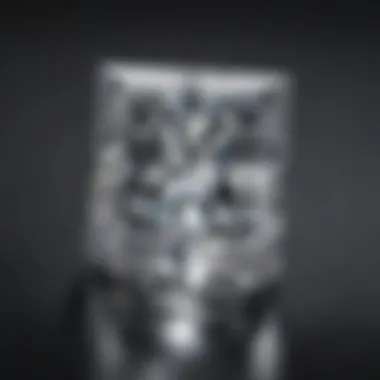

Quality Factors
Color and Clarity Grades
Color and clarity play vital roles in determining the quality and final value of a two carat princess cut diamond. The GIA color scale ranges from D (colorless) to Z (light yellow), and most buyers often aim for diamonds in the G to J range for a harmonious balance of value and look.
The key characteristic of color quality in a two carat diamond is its visual impact. Diamonds with higher color grades typically exhibit less color or tint, allowing for a more brilliant appearance under different lighting conditions. On the flip side, diamonds with lower color grades may reflect unwanted shades, thereby affecting their overall desirability.
Unique features to be aware of include how a diamond's setting can influence perceived color. With the right choice of metal, a diamond that falls slightly lower on the color grade can appear much crisper. Buyers must also consider clarity, which assesses inclusions and blemishes. For diamonds in the two carat range, a minimum clarity grade of VS2 or higher is often suggested to ensure visible cleanliness. However, those honing in on diamonds with natural inclusions might find charm in their uniqueness, but they must weigh this against clarity expectations.
Cut Quality Assessment
Cut quality is arguably one of the most pivotal aspects determining a diamond's brilliance and light performance. It reveals how well the diamond has been shaped and polished, significantly influencing how light enters and exits the stone. The cut grades can range from Excellent to Poor, with higher grades commanding higher prices.
The key characteristic of cut quality in a two carat princess cut falls into the realm of aesthetics. A well-cut diamond has the potential to reflect light in a way that creates extraordinary fire and scintillation. Notably, sharper corners and a well-finished pavilion contribute to a captivating shine that catches the eye.
Unique features often relate to how cut quality can enhance a diamond's perceived size. A well-cut diamond not only appears larger due to its optimal light performance but also shows less color due to its light-dispersive properties. However, diamonds that fall short in cut quality may appear dull or lifeless, losing much of their potential allure.
A careful consideration of color, clarity, and cut quality plays an integral role in the holistic evaluation of a two carat princess cut diamond, guiding potential buyers to make sound decisions powered by knowledge.
Comparative Analysis: One Carat vs Two Carat
The journey into the realm of diamonds often spirals around carat weight, a characteristic that holds significant sway over both aesthetic and financial dimensions. In this analysis, we delve into the nuanced contrasts between one carat and two carat princess cut diamonds. Understanding these distinctions is crucial for enthusiasts and buyers alike, as it can shape choices that transcend mere visual appeal.
Size and Visual Differences
When discussing size and visual impact, the difference between one and two carat diamonds cannot be overstated. A one carat diamond typically measures around 5.5 mm across, while its two carat counterpart generally extends to about 8 mm. This increase in dimension can create a notable difference in how the stone interacts with light, contributing to the diamond's brilliance and fire.
In various settings, the one carat stone often appears more modest, suitable for those who prefer understated elegance. On the other hand, a two carat diamond captures attention effortlessly, representing a bold statement. Many prospective buyers opt for the larger carat not just for the increased surface area, but for the enhanced presence it maintains in styles such as solitaires or halo settings. This alluring heft can become a focal point in jewelry, turning heads and igniting conversations.
"The size of a diamond can dictate not only its visual impact but also how others perceive its significance."
Some might argue that the visual difference between one and two carats is marginal when viewed from afar; yet, for those who value the subtleties of elegance, the distinction is pronounced and noteworthy.
Value and Pricing Considerations
When it comes to price, the leap from one carat to two carats represents much more than simple arithmetic; it’s a common trap for many buyers. Generally, a two carat princess cut diamond can command nearly double the price of a one carat stone, but factors such as clarity, color, and cut quality also sharply influence the final valuation.
Additionally, market conditions fluctuate based on demand and availability, meaning that the price increase might not be linear or predictable. Those interested in investing in diamonds often weigh the immediate costs against long-term value retention. Diamonds of superior quality in larger sizes tend to hold their value better over time, making a two carat stone a potential target for savvy investors.
Here are a few points to consider regarding value:
- One Carat Diamonds:
- Two Carat Diamonds:
- Generally more affordable, appealing for budget-conscious buyers.
- More accessible in terms of purchasing options.
- Higher price reflects rarity and desirability.
- Can serve as a status symbol, often valued by investors.
As the expression goes, "You get what you pay for," and understanding how carat weight translates into investment can be as intricate as the diamonds themselves.
Market Trends and Consumer Preferences
In today’s market, consumer preferences have shifted notably over the last few years. While a one carat diamond has traditionally been viewed as standard for engagements, there's been a trend towards larger carat sizes, with two carat stones gaining traction among couples eager to showcase their personal style and financial means.
Moreover, buyers today are increasingly educated about diamond purchasing, seeking quality in conjunction with size. This awareness drives a demand for stones that encapsulate more than just the carat weight, urging jewelers to provide detailed reports on quality metrics.
Popular trends among consumers include:
- Preferences for ethically sourced diamonds, which can influence buying habits significantly.
- Interest in customization, leading to unique settings that highlight the diamond's carat size effectively.
- Awareness about alternatives, such as lab-grown diamonds, that offer more competitive pricing without sacrificing aesthetics.
Ultimately, the considerations around carat size are multifaceted, revealing layers of personal choice, market trends, and emotional significance that guide buyers’ decisions. By comprehending these elements, prospective buyers can navigate the intricate diamond landscape with confidence.
Investment Considerations
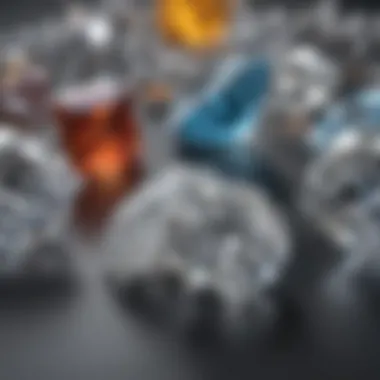
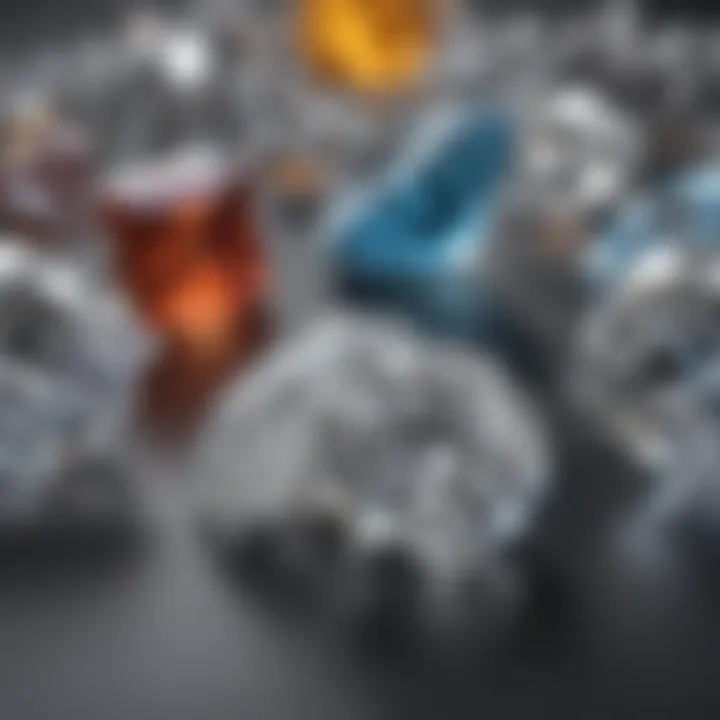
When diving into the realm of princess cut diamonds, it's essential to consider not just the beauty and craftsmanship but also the investment potential. Investing in diamonds requires an understanding of various factors that can influence value over time. This is especially true when comparing one carat and two carat diamonds, as the nuances in investment risk and reward can vary significantly between the two weights.
Value Retention Over Time
The capacity for a diamond's value to hold or even appreciate over the years is a crucial component to ponder. Diamonds, particularly those with high quality, often maintain their worth much better than other forms of investment. However, several factors can impact this retention.
- Quality of the Diamond: A well-cut diamond with exceptional clarity and color is more likely to retain its value. This is particularly important for princess cut diamonds, where cut quality is paramount.
- Market Trends: Understanding market demands is vital. Trends shift based on consumer tastes, economic factors, and even social influences. Generally, larger stones like two carats may attract more attention, driving up their resale price.
- Rarity and Demand: Two carat diamonds are rarer than one carat stones, thereby offering potential for higher returns due to their desirability.
The price of diamonds is not just about what you pay but also about what you can earn down the line. Take time to assess your diamond's future marketability.
Market Demand Insights
Keeping an ear to the ground regarding market demand can aid collectors and investors alike in making savvy choices.
- Consumer Preferences: Demand is often driven by what is currently in vogue. That means styles, cuts, and even sizes can fluctuate with trends. Certain seasons or celebrity endorsements may open up the floodgates for preferences toward larger or more ornate diamonds.
- Economic Factors: The overall economy can greatly affect consumer spending power. During prosperous times, larger, more opulent diamonds might see a surge in demand, whereas during economic downturns, one carat diamonds could become more appealing for budget-conscious buyers.
- Investment Shifts: Keep an eye on how the diamond market interacts with other investments. In times of economic uncertainty, tangible assets like diamonds can be seen as a safe haven, possibly driving demand for both one and two carat stones.
By understanding these investment considerations, buyers can approach the purchase of princess cut diamonds with a more rounded perspective, balancing beauty and long-term value.
Emotional and Symbolic Significance
The choice of a diamond is seldom about mere aesthetics. It often embodies emotions and sentiments, signifying moments and milestones that shape personal narratives. When considering one carat versus two carat princess cut diamonds, the emotional and symbolic significance cannot be overlooked. These diamonds do not just sparkle; they tell a story of love, commitment, and individual taste.
Symbolism of Carat Weight in Relationships
Carat weight serves as more than just a measurement; it's a representation of the bond between partners. A one carat diamond may signify simplicity and elegance—qualities often associated with genuine, uncomplicated love. In contrast, a two carat diamond can symbolize abundance and grandeur, reflecting a deepening commitment or a significant life event, such as an anniversary.
Some individuals interpret larger stones as a testament to the giver's love and devotion. Surprisingly, survey data show that many people prefer smaller stones that offer a balance of beauty and affordability. Carat weight therefore becomes a paradox; while larger stones command attention, the sentiment behind the gift often reigns supreme.
In relationships, words carry weight, but stones do as well. Often, a larger diamond can evoke feelings of more significant investment—both emotionally and financially. This investment signifies the hopes and dreams of a shared future. The implications of carat weight can impact personal perceptions and societal expectations within relationships, where a size difference might suggest differing values.
"The diamond isn't just a gem; it's a beacon of what we share, a reflection of our journey together."
Choosing the Right Diamond for Engagement
Selecting a diamond, particularly for engagement, involves not just personal taste but also an understanding of what the choice conveys. Understanding the difference between a one carat and a two carat diamond is essential in this decision-making process.
- Understanding Personal Preferences: One must keep in mind the tastes of the recipient. Some might adore a dazzling two carat stone, while others may appreciate the understated elegance of a one carat. Knowing your partner’s authentic style will steer you in the right direction.
- Budget Considerations: It’s important to remember that financial circumstances vary widely. More is not always merrier; a well-considered one carat diamond can symbolize a thoughtful investment more than an exceedingly larger one purchased under duress.
- The Ring Setting: Another factor is the ring’s setting. A simple band highlights a one carat stone’s brilliance, while a more elaborate setting may elevate the visual impact of a two carat stone, making it essential to choose a combination that reflects the recipient's style.
- Consulting with Experts: Jewelers can often provide insights on what choice aligns best with quality and aesthetics. They also offer an eye for detail and the latest trends to ensure that the chosen diamond garners the utmost appreciation.
The right diamond can speak volumes, drawing attention to the bond you share and representing your journey together. While carat weight carries significance, ultimately it is the emotion behind the selection that defines its true meaning.
Care and Maintenance of Princess Cut Diamonds
Taking care of a princess cut diamond is crucial, not just to maintain its beauty but also to preserve its value over time. Diamonds, particularly those cut in the princess style, are quite stunning when they catch the light, however, they also require specific maintenance to keep their sparkle intact. A well-maintained diamond reflects the thoughtful consideration behind the purchase and can serve as a long-lasting investment.
Cleaning Techniques for Princess Cuts
Keeping your princess cut diamond clean is paramount. Over time, dirt, oil, and environmental factors can dull its shine. Luckily, cleaning is straightforward and can be done at home with relative ease. Here’s how:
- A Simple Soak: Begin by mixing a few drops of mild dish soap with warm water. Avoid harsh chemicals, as they can damage the stone. Let the diamond soak for about 20 to 30 minutes.
- Gentle Scrubbing: After soaking, use a soft-bristled toothbrush to gently scrub the diamond, focusing on the areas that can trap dirt such as the corners of the princess cut. Being gentle is vital to avoid scratching.
- Rinse and Dry: After cleaning, rinse the diamond under running water, ensuring no soapy residue remains. Carefully dry it with a lint-free cloth.
- Professional Cleaning: For a deeper clean, consider taking the diamond to a jeweler for ultrasonic cleaning about once a year.
Tip: Always check that the diamond is properly set before cleaning. An insecure setting can lead to loss during the cleaning process.
Storing and Protecting Your Stone
Proper storage of your princess cut diamond is just as important as cleaning it. Diamonds are tougher than most gemstones, but they can scratch softer stones or damage themselves if stored improperly. Here are some guidelines:
- Separate Storage: Always store your diamond away from other jewelry. Using a soft cloth or a jewelry pouch can prevent scratches and damage.
- Ideal Environment: Keep the diamond in a cool, dry place. High humidity or heat can affect the setting of the diamond.
- Secure Settings: Regularly check the setting of your diamond to ensure it’s firm and secure. This is especially important if you wear the jewelry regularly.
- Avoiding Impacts: While diamonds are durable, impacts can lead to chips or fractures. When engaging in physical activities, it’s best to remove your diamond jewelry and store it safely.
Practicing these simple yet effective care techniques will keep your princess cut diamond looking its best and enhance its longevity. Keeping it clean and well-stored not only preserves its aesthetic appeal but also guards your investment over the years.
The End
Concluding this examination provides a crucial perspective on one carat and two carat princess cut diamonds, emphasizing the significance of informed decision-making when selecting such gemstones. As we journeyed through the attributes each carat size brings to the table—size perception, quality factors, and emotional weight—it's clear that diamonds are not just a purchase, but an investment in a story and a symbol of commitment. Understanding the nuances allows buyers to align their choices with personal values and budget considerations, ensuring that it's not merely a matter of size but also of resonance and meaning.
Making an Informed Decision
When it comes to choosing between a one carat or two carat princess cut diamond, several factors should be given careful thought:
- Budget: Knowing how much you are willing to invest is fundamental. Larger diamonds, while visually impressive, come with a steeper price tag. Restructuring your expectations can lead to alternative options, like prioritizing quality over size, which often leads to greater satisfaction.
- Lifestyle and Wearability: A larger diamond might sparkle more but it could also demand more attention in terms of maintenance and care. If the wearer's lifestyle is on the adventurous side, a one carat diamond might be less cumbersome while still providing that elegant touch.
- Setting: The chosen setting can quite dramatically affect how the diamond is perceived. Consider what style (solitaire, halo, etc.) would best complement the size you are considering. A smaller diamond in a more elaborate setting can appear equally captivating as a larger diamond in a simpler cage.
- Future Considerations: Think about potential changes in life circumstances. A two carat diamond could signify a significant milestone, but as one's journey unfolds, preferences can evolve. Remember, the emotional weight a diamond carries can often transcend physical dimensions.
In the end, it isn't just about whether to go for one carat or two carats. The choice should reflect personal sentiments, financial readiness, and future aspirations. Whether you lean towards the elegant subtlety of a one carat stone or the bold statement of a two carat jewel, it's about capturing the essence of the moment and making an informed decision that truly resonates with you.







